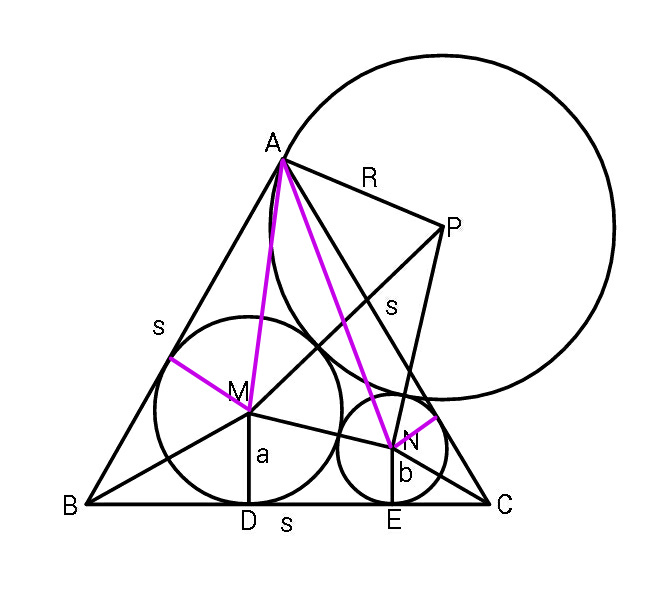Question Number 53168 by ajfour last updated on 18/Jan/19

Commented by ajfour last updated on 19/Jan/19

$${Equilateral}\:\bigtriangleup{ABC}\:\:{contains} \\ $$$${two}\:{circles}\:\:{of}\:{radii}\:{a}\:{and}\:{b}\:{in}\:{the} \\ $$$${manner}\:{shown}.\:{Find}\:{the}\:{radius} \\ $$$${R}\:{of}\:{a}\:{circle}\:{that}\:{touches}\:{these}\:{two} \\ $$$${circles}\:{externally}\:{and}\:{passes}\:{through} \\ $$$${vertex}\:{A}\:{in}\:{terms}\:{of}\:\boldsymbol{{a}}\:{and}\:\boldsymbol{{b}}.\:\:\:\:\:\: \\ $$
Commented by behi83417@gmail.com last updated on 18/Jan/19

$${R}={b}.\frac{{a}+{b}}{{a}−{b}}\:\:? \\ $$
Commented by ajfour last updated on 18/Jan/19

$${so}\:{quick}!\:{how}\:{do}\:{you}\:{get}\:{it}\:? \\ $$
Commented by behi83417@gmail.com last updated on 18/Jan/19

$${side}\:{s}\:{is}\:{missing}\:{in}\:{your}\:{commonet}. \\ $$
Commented by ajfour last updated on 18/Jan/19

$${s}\:{is}\:{not}\:{even}\:{required},\:{solution}\:{sir}? \\ $$
Commented by MJS last updated on 20/Jan/19

$${s}=\mathrm{1}\wedge\frac{\sqrt{\mathrm{3}}}{\mathrm{18}}<{a}<\frac{\sqrt{\mathrm{3}}}{\mathrm{6}}:\:{b}=\frac{\mathrm{1}}{\mathrm{3}}\left(\sqrt{\mathrm{3}}−{a}−\mathrm{2}\sqrt{\sqrt{\mathrm{3}}{a}−\mathrm{2}{a}^{\mathrm{2}} }\right) \\ $$$$\mathrm{for}\:\mathrm{these}\:\mathrm{values}\:\mathrm{both}\:\mathrm{circles}\:\mathrm{stay}\:\mathrm{within}\:\mathrm{the} \\ $$$$\mathrm{triangle}\:\mathrm{and}\:\mathrm{the}\:\mathrm{big}\:\mathrm{circle}\:\mathrm{exists} \\ $$$$\mathrm{I}\:\mathrm{haven}'\mathrm{t}\:\mathrm{been}\:\mathrm{able}\:\mathrm{to}\:\mathrm{get}\:\mathrm{the}\:\mathrm{coordinates} \\ $$$$\mathrm{of}\:{P}\:\mathrm{or}\:\mathrm{the}\:\mathrm{value}\:\mathrm{of}\:{r} \\ $$
Answered by mr W last updated on 19/Jan/19

Commented by mr W last updated on 19/Jan/19

$${s}=\sqrt{\mathrm{3}}\left({a}+{b}\right)+\sqrt{\left({a}+{b}\right)^{\mathrm{2}} −\left({a}−{b}\right)^{\mathrm{2}} }=\sqrt{\mathrm{3}}\left({a}+{b}\right)+\mathrm{2}\sqrt{{ab}} \\ $$$${AM}=\sqrt{\left({s}−\sqrt{\mathrm{3}}{a}\right)^{\mathrm{2}} +{a}^{\mathrm{2}} }=\sqrt{\left(\sqrt{\mathrm{3}}{b}+\mathrm{2}\sqrt{{ab}}\right)^{\mathrm{2}} +{a}^{\mathrm{2}} }=\sqrt{{a}^{\mathrm{2}} +\mathrm{3}{b}^{\mathrm{2}} +\mathrm{4}{ab}+\mathrm{4}{b}\sqrt{\mathrm{3}{ab}}} \\ $$$${AN}=\sqrt{\left({s}−\sqrt{\mathrm{3}}{b}\right)+{b}^{\mathrm{2}} }=\sqrt{\mathrm{3}{a}^{\mathrm{2}} +{b}^{\mathrm{2}} +\mathrm{4}{ab}+\mathrm{4}{a}\sqrt{{ab}}} \\ $$$${MN}={a}+{b} \\ $$$${PM}={a}+{R} \\ $$$${PN}={b}+{R} \\ $$$${AP}={R} \\ $$$${let}\:\angle{APM}=\alpha,\:\angle{MPN}=\beta \\ $$$$\mathrm{cos}\:\alpha=\frac{{R}^{\mathrm{2}} +\left({R}+{a}\right)^{\mathrm{2}} −\left({a}^{\mathrm{2}} +\mathrm{3}{b}^{\mathrm{2}} +\mathrm{4}{ab}+\mathrm{4}{b}\sqrt{\mathrm{3}{ab}}\right)}{\mathrm{2}{R}\left({R}+{a}\right)} \\ $$$$\Rightarrow\mathrm{cos}\:\alpha=\frac{\mathrm{2}{R}^{\mathrm{2}} +\mathrm{2}{aR}−\mathrm{3}{b}^{\mathrm{2}} −\mathrm{4}{ab}−\mathrm{4}{b}\sqrt{\mathrm{3}{ab}}}{\mathrm{2}{R}\left({R}+{a}\right)} \\ $$$$\mathrm{cos}\:\beta=\frac{\left({R}+{a}\right)^{\mathrm{2}} +\left({R}+{b}\right)^{\mathrm{2}} −\left({a}+{b}\right)^{\mathrm{2}} }{\mathrm{2}\left({R}+{a}\right)\left({R}+{b}\right)} \\ $$$$\Rightarrow\mathrm{cos}\:\beta=\frac{{R}^{\mathrm{2}} +\left({a}+{b}\right){R}−{ab}}{\left({R}+{a}\right)\left({R}+{b}\right)} \\ $$$$\mathrm{cos}\:\left(\alpha+\beta\right)=\frac{{R}^{\mathrm{2}} +\left({R}+{b}\right)^{\mathrm{2}} −\left(\mathrm{3}{a}^{\mathrm{2}} +{b}^{\mathrm{2}} +\mathrm{4}{ab}+\mathrm{4}{a}\sqrt{{ab}}\right)}{\mathrm{2}{R}\left({R}+{b}\right)} \\ $$$$\Rightarrow\mathrm{cos}\:\left(\alpha+\beta\right)=\frac{\mathrm{2}{R}^{\mathrm{2}} +\mathrm{2}{bR}−\mathrm{3}{a}^{\mathrm{2}} −\mathrm{4}{ab}−\mathrm{4}{a}\sqrt{{ab}}}{\mathrm{2}{R}\left({R}+{b}\right)} \\ $$$$ \\ $$$$\Rightarrow\mathrm{cos}^{−\mathrm{1}} \frac{\mathrm{2}{R}^{\mathrm{2}} +\mathrm{2}{bR}−\mathrm{3}{a}^{\mathrm{2}} −\mathrm{4}{ab}−\mathrm{4}{a}\sqrt{{ab}}}{\mathrm{2}{R}\left({R}+{b}\right)}=\mathrm{cos}^{−\mathrm{1}} \frac{\mathrm{2}{R}^{\mathrm{2}} +\mathrm{2}{aR}−\mathrm{3}{b}^{\mathrm{2}} −\mathrm{4}{ab}−\mathrm{4}{b}\sqrt{\mathrm{3}{ab}}}{\mathrm{2}{R}\left({R}+{a}\right)}+\mathrm{cos}^{−\mathrm{1}} \frac{{R}^{\mathrm{2}} +\left({a}+{b}\right){R}−{ab}}{\left({R}+{a}\right)\left({R}+{b}\right)} \\ $$$${let}\:\mu=\frac{{b}}{{a}},\:\lambda=\frac{{R}}{{a}} \\ $$$$\Rightarrow\mathrm{cos}^{−\mathrm{1}} \left\{\mathrm{1}−\frac{\mathrm{3}+\mathrm{4}\mu+\mathrm{4}\sqrt{\mu}}{\mathrm{2}\lambda\left(\lambda+\mu\right)}\right\}=\mathrm{cos}^{−\mathrm{1}} \left\{\mathrm{1}−\frac{\mathrm{3}\mu^{\mathrm{2}} +\mathrm{4}\mu+\mathrm{4}\mu\sqrt{\mathrm{3}\mu}}{\mathrm{2}\lambda\left(\lambda+\mathrm{1}\right)}\right\}+\mathrm{cos}^{−\mathrm{1}} \left\{\mathrm{1}−\frac{\mathrm{2}\mu}{\left(\lambda+\mathrm{1}\right)\left(\lambda+\mu\right)}\right\} \\ $$$$\Rightarrow\lambda=\lambda\left(\mu\right)…. \\ $$
Commented by ajfour last updated on 19/Jan/19

$${Thanks}\:{sir},\:{very}\:{better}\:{way},\:{i}\:{had} \\ $$$${resorted}\:{to}\:{a}\:{coordinate}\:{like}\:{method}. \\ $$
Answered by ajfour last updated on 19/Jan/19

Commented by ajfour last updated on 19/Jan/19

$${let}\:{midpoint}\:{of}\:{BC}\:{be}\:{origin}\:{O}, \\ $$$${with}\:{x}-{axis}\:{along}\:{BC}. \\ $$$${M}\left(−\frac{{s}}{\mathrm{2}}+{a}\sqrt{\mathrm{3}},\:{a}\right)\:\:;\:{N}\left(\frac{{s}}{\mathrm{2}}−{b}\sqrt{\mathrm{3}},\:{b}\right) \\ $$$${A}\left(\mathrm{0},\frac{{s}\sqrt{\mathrm{3}}}{\mathrm{2}}\right)\:;\:\:{s}=\sqrt{\mathrm{3}}\left({a}+{b}\right)+\mathrm{2}\sqrt{{ab}} \\ $$$${let}\:\:{P}\:\left({h},{k}\right).\:\:{As}\:{MP}\:=\:{a}+{R} \\ $$$$\left({h}+\frac{{s}}{\mathrm{2}}−{a}\sqrt{\mathrm{3}}\right)^{\mathrm{2}} +\left({k}−{a}\right)^{\mathrm{2}} =\left({a}+{R}\right)^{\mathrm{2}} \\ $$$${As}\:{NP}\:=\:{b}+{R} \\ $$$$\:\left({h}−\frac{{s}}{\mathrm{2}}+{b}\sqrt{\mathrm{3}}\right)^{\mathrm{2}} +\left({k}−{b}\right)^{\mathrm{2}} =\left({b}+{R}\right)^{\mathrm{2}} \\ $$$${as}\:{AP}\:=\:{R} \\ $$$$\:\:\:\:{h}^{\mathrm{2}} +\left(\frac{{s}\sqrt{\mathrm{3}}}{\mathrm{2}}−{k}\right)^{\mathrm{2}} =\:{R}^{\mathrm{2}} \:. \\ $$
